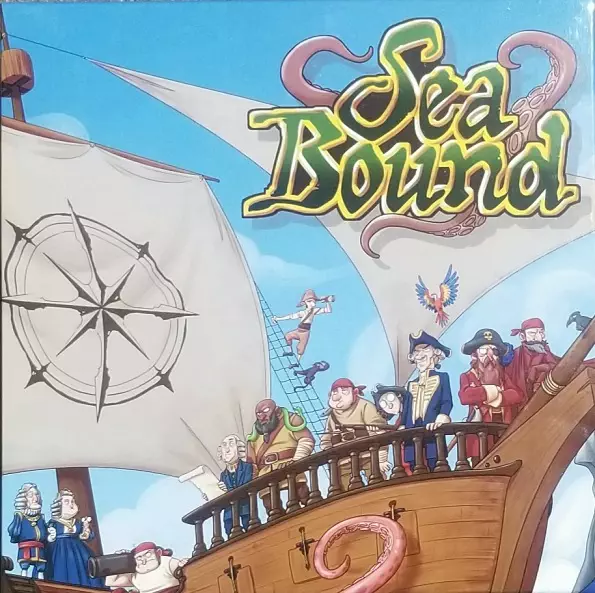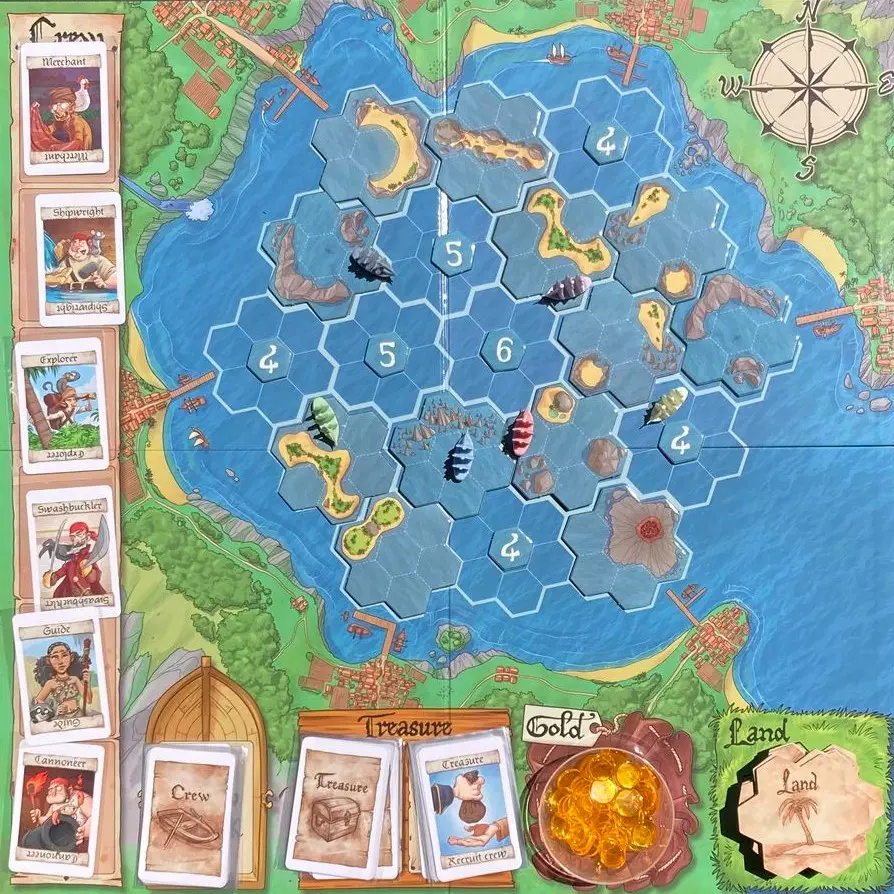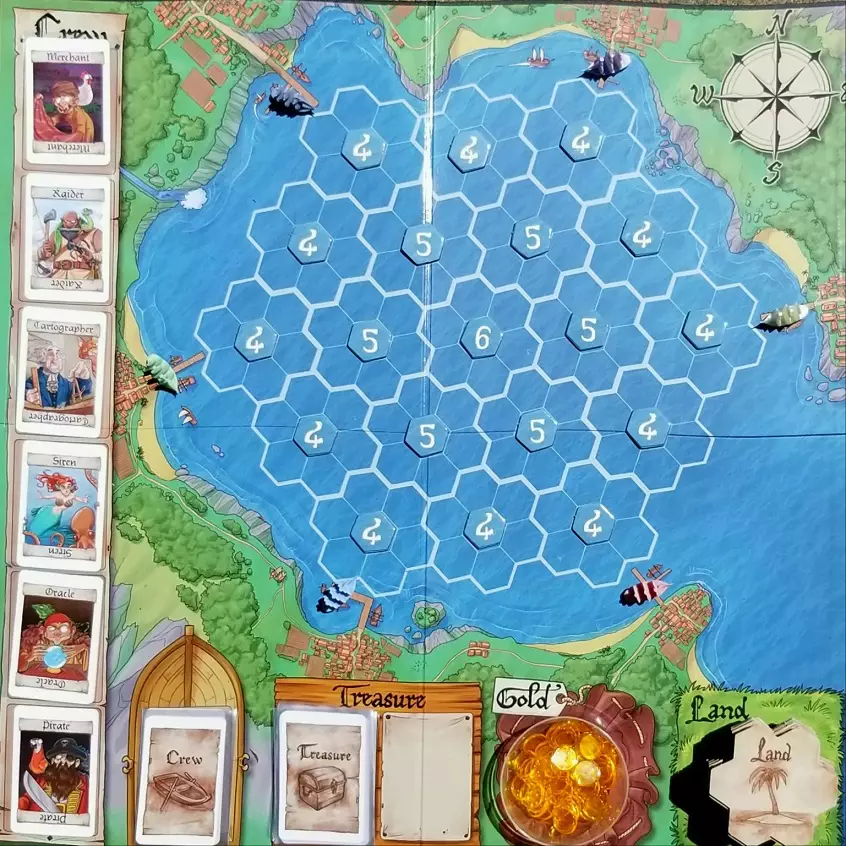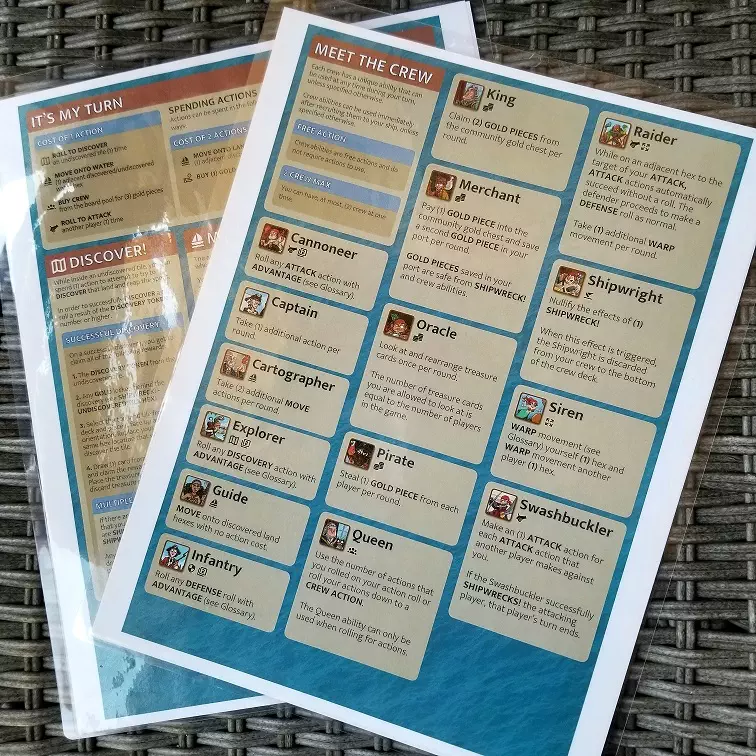
Yo ho, yo ho, it’s a new pirate game for me! We love pirate games here at the Cardboard Cantina and have picked up quite a few because of it. Coming across one that has a unique take on the genre is, for us anyway, much like finding buried treasure – and Seabound is one that certainly has our attention! Weighted Dice Games was gracious enough to send us a prototype copy for their upcoming crowdfunding campaign to explore and write about. However, we had so much fun playing the game with our friends that we got behind in finishing our actual review! With all of that being said, it is time to weigh anchor and loose the sails as we take a closer look at Seabound!
The themes of nautical exploration and naval combat are not new by any means. However, designers Samuel Harmon and Christopher Burkitt have combined them with several unique elements that set their game apart from many in the pirate genre that we have played. In this 3-6 player board game, players are pitted against one another as they try to tame the seas by discovering new lands, engaging in naval battles, and accruing treasure. On their turn, players begin by rolling a d6 to determine how many action points they get to spend. At first, that can seem swingy or wildly unfair. However, in truth, the game mechanics balance out any one player getting too far ahead of the group. We found this to be distinctive and refreshingly new, especially for such a lightweight game. The combat system is also one that stands out, but mostly due to the relaxed style of gameplay. Players simply need to declare a target anywhere on the board (range and proximity are not a factor), roll a die, and give their opponent a chance to defend. This approach solidifies that Seabound is meant to be extremely casual (think “beer and pretzels” level of light and fun). The game takes an average of 30ish minutes to play, give or take a few exceptions. With the entirety of the rules system, including Crew explanations and a glossary of terms, only taking up four 8.5×11 pages, the gameplay is quick-paced and enjoyable without too much strategizing and overthinking.
To play Seabound, each player chooses a starting port and places their ship in one of the two adjacent spaces. Any earned action points are spent moving, discovering new areas, attacking other ships, amassing gold, or one of the various other options. Right from the start, players need to explore as they cannot move from one unexplored space to another. The map will quickly start to fill in as tiles are placed and routes are established. Successfully revealing a new map tile will earn that pirate a treasure card, which is usually an amount of gold to hold on to for end-game scoring or the chance to hire crew for free. Beware of getting stuck in unexplored spaces, however. If another ship should pass its roll on the shared zone then you would become shipwrecked, (which is also a result of being attacked) and that’s never a good thing. Shipwrecked players lose their gold and get sent back to port, and, while that sounds bad, the varied processes of how this is resolved create new and interesting ways for the game to progress as you quickly get back into the action. The game will end when all map zones have been revealed. That alone provides interesting play as each pirate prioritizes exploration or grabbing more loot before the game is complete.
Seabound‘s prototype is exquisite. Sure, there were a few errors that will be fixed before the final copies are sent to print, but even with these errors, this is one of the best-quality prototypes we have ever received. However, after a few games, we have a few critical points that we hope will be considered before the game launches for funding. We’d love to see each player get their own copy of the player aid for the Crew cards and how to spend their action points (full-sized sheets of paper like in the prototype are fine). Passing the one copy back and forth nearly every turn got a bit tedious and added unnecessarily to the play time. Putting the Crew abilities on their individual cards, either with text or symbol(s), would make the game easier to learn and more approachable for new players. We feel these changes, while seemingly minor, would make a huge impact on the game. Additionally, the game is marketed as being for 3-6 players. While this is accurate, the game truly shines at 4+ as 3-player games tended to feel more like playing a game of “monkey in the middle.” This can be discouraging for some individuals or groups.
As the debut game for both the design team and Weighted Dice Games itself, Seabound blew us away. With the amount of potential player interaction, simple rules, and use of light mechanics, it kept even our most analysis paralysis-prone players enthralled and up in the action. To help drive the theme home, the game features artwork from Jordi Planellas. While this is the first game from the designer duo, Jordi Planellas’ art can also currently be found in Tricky Goblins from OwlDragon Adventures. Additionally, Planellas is, in our opinion, a notable cartoonist, comic artist, and illustrator based on what we have seen of his other works. We’re looking forward to seeing this game launch on Kickstarter soon and are excited to see how the campaign progresses. Hopefully Seabound will be the first of many games to come from this new publisher!
All photos of Weighted Dice Games products were taken and edited by Krista.


